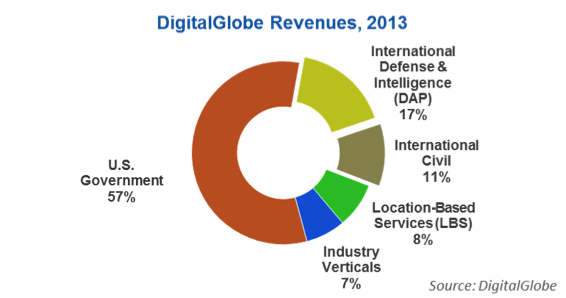DigitalGlobe/AstriumGEO
– Niche vs. Mass Market
Nov 26th, 2013
by Stéphane
Gounari, NSR
DigitalGlobe held an
Investor Day on November 20 where it described its
strategy focused on key customers & partners. A week
before, AstriumGEO conducted a Webinar presenting
its Cloud solution; a product focused on numerous EO
end-users. Their strategies, while increasingly
different, look like a classic
Niche vs. Mass Market
opposition.

DigitalGlobe’s
customer base is very concentrated;
a few customers represent a large share of the
revenues. While the company aims to develop its
revenues from commercial companies (LBS and others),
it does not
plan any
radical strategy changes.
At the
same time, the company wants to increase revenue
from Processing and Information Services and to do
so, DigitalGlobe wants to leverage its imaging,
archive and processing capabilities through in-house
analytical solutions and through a network of
partners (as ESRI); thus through
internal capabilities and
key, selected partners.
This strategy is possible thanks to its imaging
capabilities (spatial resolution and spectrum),
which open the way to unique analytical solutions,
thus to
niche markets.
By focusing on key customers in niche markets and
using key partners, DigitalGlobe’s goal is to
maximize revenues while minimizing the cost of sales
through maximum efficiency. This should lead to
high-margin
revenues.
In 2012, less than 50%
of AstriumGEO’s revenues originated from Defense &
Intelligence customers; around 30% was from
commercial customers, and while Europe is the main
regional market, Asia is not far behind.
AstriumGEO’s
customer base is less concentrated than DigitalGlobe,
and
AstriumGEO’s
Cloud solution is in line with this strategy. It
allows users to directly task, order and process
imagery, but also to integrate it with other types
of data. As such, it
provides a
single-point-of-access to independent Information
Services providers
and end-users. The solution does not require
specific bilateral agreements, is open to every
player and is tailored toward SMEs.
This strategy is possible thanks to a very large
choice of imagery and a larger size than most of its
competitors. AstriumGEO’s strategy should attract
numerous
SMEs
looking for imagery that is easy to access and use,
including most likely start-ups developing
cutting-edge analytical solutions. AstriumGEO will
be able to
tap into the vast network
of Information Services
companies,
extending the range of applications for its imagery.
This should ensure a
large, diversified and
constantly evolving usage of AstriumGEO imagery.
Bottom Line
Both business models
are in line
with their current customer mix and imaging
capabilities;
however, both have specific challenges.
DigitalGlobe will continue to rely on large
customers, with the
risk associated.
Besides its internal analytical capabilities, it
will leverage those of a few selected partners; to a
certain extent this
will limit the applications
and potentially the
innovation rate.
Moreover niche markets are
limited in size,
which will force DigitalGlobe to either
create new
applications or address the mass market.
As its distribution system is not optimized for the
mass market, DigitalGlobe’s imagery will be less
easy to use, thus
losing value when compared
to EO satellite operators with a mass market focus.
As for AstriumGEO, a
mass market
focus implies lower margins.
To compensate, AstriumGEO will have to
capture a large(r)
share of the market.
At the same time, other EO satellite operators with
similar imaging capabilities will most likely choose
the same cloud-strategy; therefore, AstriumGEO will
have to constantly improve its own Cloud solution or
lose the value it brings to its own imagery and be
forced to more intensely compete on price.









